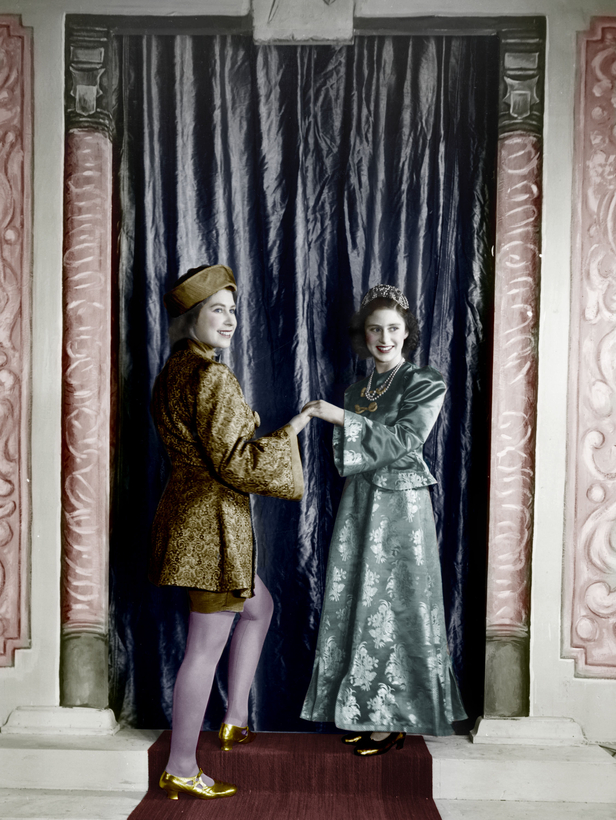“Poor darlings, they have never had any fun yet,” King George VI wrote on V-E Day in 1945. He actually knew better. He had instigated plenty of fun for the future Queen Elizabeth II and her sister, Princess Margaret, during their war years at Windsor Castle. But the notion of their adolescent lives as a kind of purdah hardened over time into conventional wisdom.
Now comes a parade of delicious details to persuade us otherwise in The Windsor Diaries. Alathea Fitzalan Howard was kin to the 16th Duke of Norfolk, one of the grandest aristocrats in England. Ditched by her separated parents, she spent the Second World War with her octogenarian grandfather, Lord Fitzalan of Derwent. His home was Cumberland Lodge, located beyond the famous Copper Horse statue, some three miles from Windsor Castle. The strictly religious Lord Fitzalan had been living rent-free in the vast red-brick turreted house since 1924, courtesy of his close friend the late King George V.

Alathea had been friendly with Elizabeth and Margaret as young children, and she became their steady companion when the sisters moved from Buckingham Palace to Windsor in 1940 to escape the Luftwaffe’s incessant attacks on London. Several times a week she went by bicycle or bus to the castle for lessons in drawing and dancing. The King and Queen embraced her as one of their own, with frequent invitations for luncheons, picnics, dinners, overnight stays, tea parties with the handsome grenadiers guarding the castle, and a half-dozen dazzling dances in the opulent Red Drawing Room that lasted until nearly dawn. She even appeared in the famous Christmas pantomimes starring the princesses. “It is a pity she is always the boy,” wrote Alathea of Elizabeth’s performances.
Dear Diary …
Alathea’s daily diaries captured the royal family at ground level with endearing glimpses as well as astute observations. Who knew that Princess Elizabeth had a pet chameleon and Norwegian ponies as well as corgis? Or that she and Margaret “had great fun spitting over a bridge into a stream, trying to hit leaves as they floated by!” In the winter they skated with the King on the lake at nearby Frogmore House, and in the summer they swam in the pool at Royal Lodge, the family’s home in the outskirts of Windsor Great Park near Cumberland Lodge.
Alathea was besotted by the “angelic” and “so terribly kind” Queen, whose warmth contrasted sharply with the chill of her own captious mother. She saw the royal family as “four people who mean everything to each other, whose lives form one spiritual whole, independent of the aid of all outsiders, or even relations.” Yet she cringed when they “screamed with laughter” at the Marx Brothers and other “silly” comedies among the films the King regularly showed at the castle. She concluded, with an aristocratic sniff, that they were “v. simple people.”

She adored “Lilibet,” who was three years younger. Alathea found her to be “placid and unemotional, she never desires what doesn’t come her way,” and concluded that she could “be happy as her thoughts never soar above the most ordinary.” She also took note that the naturally reserved princess shrewdly began using her dogs during receptions as “the greatest save to the conversation when it dropped”—a practice she would continue as Queen. Just once, late one evening, Elizabeth opened up about her feelings, and Alathea “saw behind the outward calm and matter-of-factness into something lovable and sincere.”
Elizabeth’s wardrobe prompted regular complaints from Alathea, who despaired over the “awful blue silk frock, with the little pleated cape,” which was “the worst thing she could possibly wear with her figure.” That figure, incidentally, featured “an enormous chest” at age 14. But her friend was generous when Elizabeth looked “delightful” in a pale yellow dress and showed a “dignified grace peculiar to herself.”
Alathea was endlessly amused by Princess Margaret, the exuberant younger sister who capered and chattered, asked embarrassing questions, mimicked ladies-in-waiting, and made “enchanting faces.” With undisguised admiration, she noted “the “frivolity and irresponsibility that Lilibet lacks.”
Alathea took note that Elizabeth shrewdly began using her dogs during receptions as “the greatest save to the conversation when it dropped”—a practice she would continue as Queen.
If confirmation were needed that Princess Elizabeth fell forever in love with Prince Philip of Greece at age 13, it is convincingly presented in these pages. Shortly before her 15th birthday, the princess confided that Philip was her “boy,” and she unabashedly shared her excitement whenever he came for the weekend while on leave from the Royal Navy. After he gave her a photograph of himself at Christmas in 1944, Elizabeth “danced round the room with it for joy!”

This was wartime, of course, and plenty of bombs fell near Windsor Castle. Elizabeth and Margaret slept in a bunk bed in an underground shelter for nearly a year. But they roamed unafraid in the woodlands, ate wild strawberries, baked scones and cooked sausages on sticks, fished in the little stream, and punted on the lake. With “unrestrained enjoyment,” they made their own fun playing charades, sardines, racing demon, and consequences.
And one day in the spring of 1944—only weeks before German V-1 pilotless missiles began terrorizing Britain—the princesses had a fête champêtre on the grounds of Royal Lodge with some of the King’s guardsmen. It was an idyll “unique and remote from this hurried noisy world,” wrote Alathea. Afterward, they rode back to the castle in a carriage as dusk fell, and they “sang all the way.”
Sally Bedell Smith is the author of Elizabeth the Queen: The Life of a Modern Monarch


